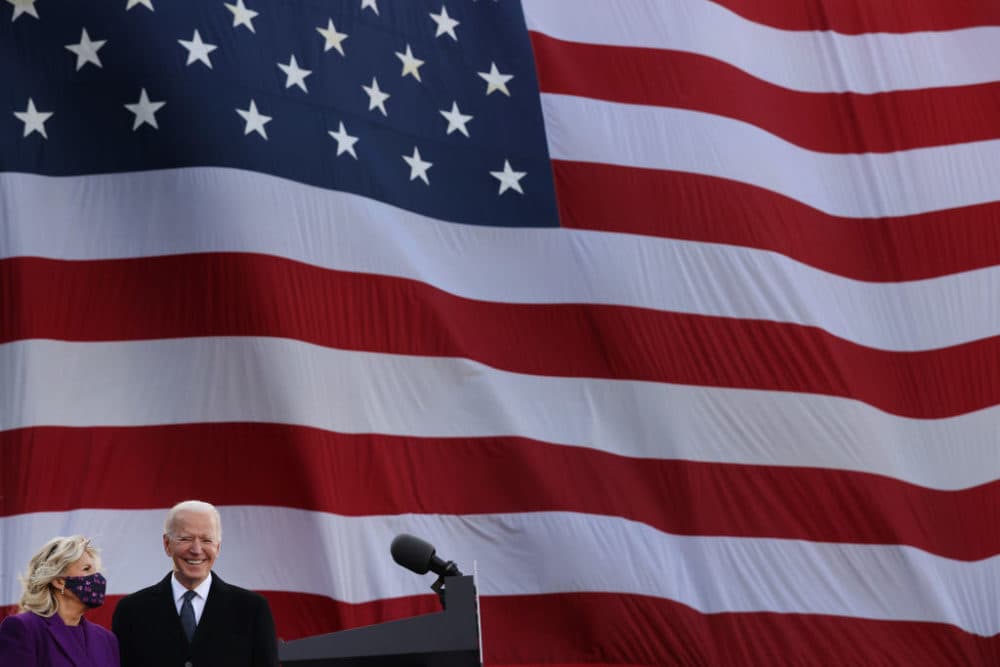Advertisement
Commentary
America Is Not As Divided As You Think. Yes, Really

President-elect Joe Biden’s inauguration speech is almost certain to include notes of unity; his aim, it’s been reported, will be to urge “a divided America to come together.” But that sentiment can feel naïve, outdated even. Especially after the first two weeks of 2021.
Political polarization is straining our democracy. Political science research links polarization to democratic breakdown — at its extreme, it can send a country sliding into authoritarianism. We know polarization creates opportunities for leaders to dismantle democracy. And highly polarized societies get caught in gridlock, making it difficult to reach decisions and implement policy. Sounds familiar, yes?
There is no doubt that polarization influences democratic ideals and principles. It is also true, however, that polarization is influenced by democratic norms and practices.
Research shows that almost 70% of Democrats and Republicans believe the country is “greatly divided” on basic values and beliefs and that negative views of individuals from either party, towards those from the other, are at an almost half-century high. But there is also a growing body of research suggesting that these perceptions of difference are out of whack with people’s actual positions and beliefs. This research on “false polarization” or “meta polarization” shows conclusively that we perceive ourselves to be more polarized than we actually are.
The constant attention to our differences is making us think that we are more polarized than we actually are.
If we use cable television or Congress as our yardstick for testing this idea, it can be hard to believe. But it’s true. The chasm between perception and reality can be explained by something called the “availability heuristic” — a cognitive bias in which our perception of the actual frequency of something is based on how often we hear about it. The constant attention to our differences is making us think that we are more polarized than we actually are.
Social scientists who study “norming” have found that people’s perceptions of what is normal are powerful in shaping behavior. By hearing so much about our differences, we overestimate them. Eventually, our misperceptions of how polarized we are, guide how we behave. This same effect is part of the reason that conspiracy theories like QAnon take root — the more people hear them and the more people they think believe them, the more the outlandish becomes feasible.
Research over the last 20 years shows that not only are people not as polarized as they think, but that they actually share many ways of thinking about social issues. For example, data are emerging that show striking consensus across political groups that reforming policing and addressing racism are necessary. And there is consensus around how we should respond to the pandemic.

Early on in this public health crisis, we read stories about communities coming together in solidarity, even as they were forced apart by social-distancing. The murder of George Floyd forced a national reckoning by appealing to a common humanity. Even this month, after extremists trashed the U.S. Capitol and surrounding areas, the aftermath told the story of the real America. A legion of veterans, upset by veterans among the rioters, cleaned up trash left on the streets; a teacher organized a campaign to send “thank you” notes to Capitol custodial staff. Neighbors similarly came together to clean up after the unrest in Baltimore, Ferguson, and Minneapolis.
These are more than just feel-good stories. They are emblematic of extant strands of our culture that are very different than the polarization we are so often reminded of.
If we advance the narratives of shared fate and solidarity that we have seen glimmers of, we can avoid falling back into the familiar two-Americas trope.
Even so, the media ecosystem we live in makes it exceedingly difficult to tune out messages of strife and conflict. We might say — and even think — that we want Democrats and Republicans to work together, but in the end, conflict sells, division grabs our attention and disagreement stokes our sense of right and wrong and the powerful emotions that come along with it. The more we hear it, the truer it becomes, thus impacting the way we think and even the way we act, including the most extreme among us.
Part of the way to curb polarization is to emphasize shared values and common dimensions of identity. Rather than feeding our perceptions of polarization, we can advance narratives of what we share, what unites us, and what we all aspire to see. We have seen the potential of this approach in projects on justice reform, where appealing to Americans’ shared sense of pragmatism moves people from all political persuasions to be critical of the death penalty. Shared values have shown similar promise on early childhood issues, where the value of collective progress generates broad backing of more robust supports for families with young children. Activating the value of interdependence — the idea that our wellbeing is intertwined and connected — has been effective on issues ranging from substance use to housing.

President-elect Biden is all in on this strategy. He plans an inauguration themed around America United, and has been disciplined in the idea of “build back better” — a pragmatic appeal to the collective American values of recovery, renewal and progress.
We don’t know how long his administration will be able to resist the pull of the division and the clickbait of conflict, but so far, the Biden camp seems to have gotten the message about the dangers of parroting the “America divided” narrative and is attempting to advance an alternative frame of what and who this country is. This framing is both a governing philosophy and a communications strategy; summon our better angels, activate a different part of our identity as Americans, and count on the country to respond.
Surely we need to take on polarization. We cannot allow it to grow. But the way to do this is by choosing to focus less of our time and attention on what divides us and more of it on what unites us. If we advance the narratives of shared fate and solidarity that we have seen glimmers of, we can avoid falling back into the familiar two-Americas trope.
Shifting away from a-country-divided narratives is the first step in bringing us together.

